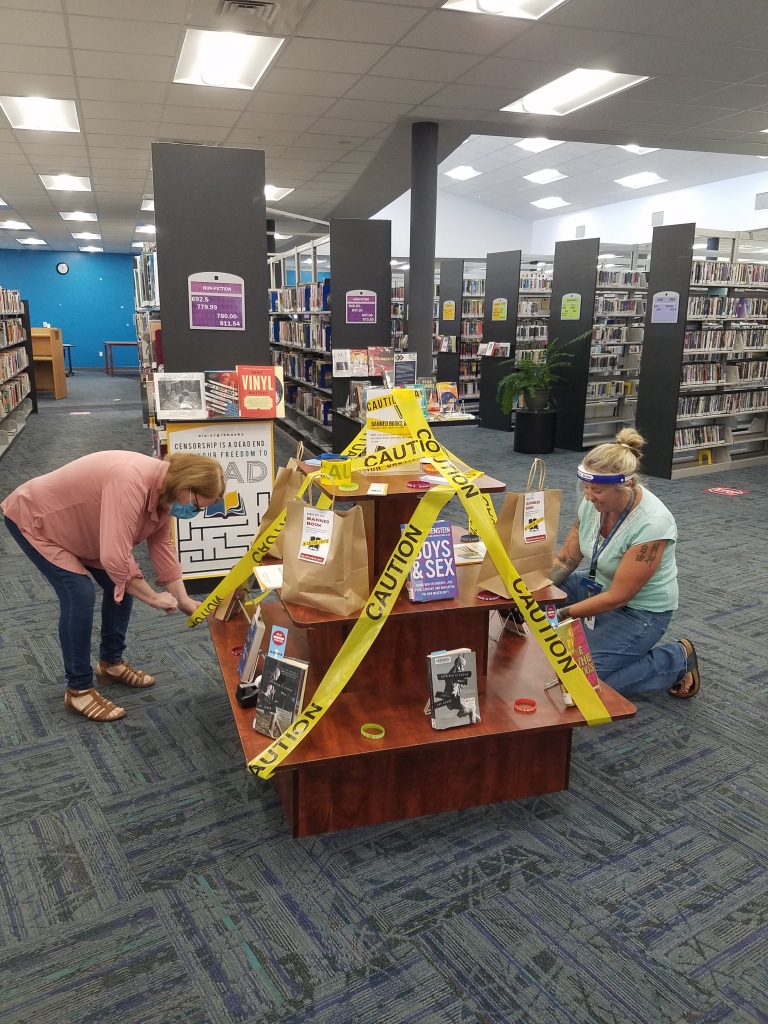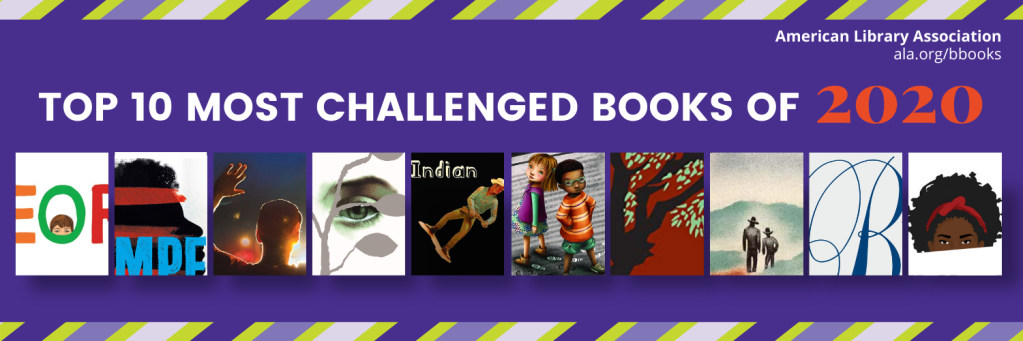
Banned Books Week:
September 26 to October 2, 2021
What is Banned Books Week?
It is an annual week-long celebration of the freedom to read!
When did it start?
In the 1982 Supreme Court case Island Tress School District v. Pico it was ruled that school officials cannot ban books in libraries because of their content. After this ruling, an initiative was put together by the Office of Intellectual Freedom (OIF), the National Association of College Stores and the American Booksellers Association to celebrate the freedom to read without censorship. This initiative was a huge success with many participants and included news coverage by The New York Times and PBS. Banned Books Week is now an annual event that is sponsored by the American Library Association and numerous others.
Why are books challenged?
People or groups challenge books, often wanting to protect others -such as children- from difficult ideas and information. The top 3 reasons for challenging materials as reported to the OIF are: the material was considered to be “sexually explicit”, the material contained “offensive language”, and the material was “unsuited to any age group” (https://www.ala.org/advocacy/bbooks/banned-books-qa).
What defines a materials challenge?
A challenge is an attempt to remove or restrict materials, based upon the objections of a person or group. What is a ban? A ban is removal of the material(s) being challenged (https://www.ala.org/advocacy/bbooks/banned).
The American Library Association’s Office of Intellectual Freedom (OIF) has documented challenged books and attempts at banning books in schools and libraries since 1990. The OIF collects reports from schools, libraries, and media reports when books get challenged. When the OIF compiles lists of the most challenged and banned books for any year(s) it gathers the information by reviewing these reports. “The American Library Association condemns censorship and works to ensure free access to information. For more information on ALA’s efforts to raise awareness of censorship and promote the freedom to read, please explore Banned Books Week” (https://www.ala.org/advocacy/bbooks/banned-books-qa).
(Source: https://www.ala.org/advocacy/bbooks/bannedbooksweek/ideasandresources/freedownloads)
Here are the top 20 banned and challenged books from 2010-2019.
1. The Absolutely True Diary of a Part-Time Indian by Sherman Alexie
2. Captain Underpants (series) by Dav Pilkey
3. Thirteen Reasons Why by Jay Asher
4. Looking for Alaska by John Green
5. George by Alex Gino
6. And Tango Makes Three by Justin Richardson and Peter Parnell
7. Drama by Raina Telgemeier
8. Fifty Shades of Grey by E. L. James
9. Internet Girls (series) by Lauren Myracle
10. The Bluest Eye by Toni Morrison
11. The Kite Runner by Khaled Hosseini
12. Hunger Games by Suzanne Collins
13. I Am Jazz by Jazz Jennings and Jessica Herthel
14. The Perks of Being a Wallflower by Stephen Chbosky
15. To Kill a Mockingbird by Harper Lee
16. Bone (series) by Jeff Smith
17. The Glass Castle by Jeannette Walls
18. Two Boys Kissing by David Levithan
19. A Day in the Life of Marlon Bundo by Jill Twiss
20. Sex is a Funny Word by Cory Silverberg
The ALA Office for Intellectual Freedom tracked 156 challenges to library, school, and university materials and services in 2020. Of the 273 books that were targeted, here are the most challenged, along with the reasons cited for censoring the books:

Top 10 Most Challenged Books of 2020
- George by Alex Gino
Reasons: Challenged, banned, and restricted for LGBTQIA+ content, conflicting with a religious viewpoint, and not reflecting “the values of our community” - Stamped: Racism, Antiracism, and You by Ibram X. Kendi and Jason Reynolds
Reasons: Banned and challenged because of author’s public statements, and because of claims that the book contains “selective storytelling incidents” and does not encompass racism against all people - All American Boys by Jason Reynolds and Brendan Kiely
Reasons: Banned and challenged for profanity, drug use, and alcoholism, and because it was thought to promote anti-police views, contain divisive topics, and be “too much of a sensitive matter right now” - Speak by Laurie Halse Anderson
Reasons: Banned, challenged, and restricted because it was thought to contain a political viewpoint and it was claimed to be biased against male students, and for the novel’s inclusion of rape and profanity - The Absolutely True Diary of a Part-Time Indian by Sherman Alexie
Reasons: Banned and challenged for profanity, sexual references, and allegations of sexual misconduct by the author - Something Happened in Our Town: A Child’s Story About Racial Injustice by Marianne Celano, Marietta Collins, and Ann Hazzard, illustrated by Jennifer Zivoin
Reasons: Challenged for “divisive language” and because it was thought to promote anti-police views - To Kill a Mockingbird by Harper Lee
Reasons: Banned and challenged for racial slurs and their negative effect on students, featuring a “white savior” character, and its perception of the Black experience - Of Mice and Men by John Steinbeck
Reasons: Banned and challenged for racial slurs and racist stereotypes, and their negative effect on students - The Bluest Eye by Toni Morrison
Reasons: Banned and challenged because it was considered sexually explicit and depicts child sexual abuse - The Hate U Give by Angie Thomas
Reasons: Challenged for profanity, and it was thought to promote an anti-police message
Source: https://www.ala.org/advocacy/bbooks/frequentlychallengedbooks/top10
Have you ready any of these titles?


